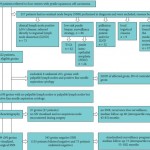Editorial: Penis cancer management – insight into the future
The report of Jakobson et al. [1] assesses the results of the sentinel node procedure for penis carcinoma in Denmark. The sentinel node procedure was done in four university hospitals. In this geographically small country with little more than 5.6 million inhabitants and a case load of 50 patients with penis cancer per year, a distribution of care of patients with penis cancer over four hospitals seems reasonable at first sight.
The results show interesting elements. With a false-negative rate of 10.8%, the figure is in accordance with what is known from other series, albeit at the high end of the range [2]. The authors rightly acknowledge that there is room for improvement. It seems likely that centralising the procedure to two hospitals, as of 2009, will be instrumental in this endeavour.
The authors did not find a learning curve, underscoring the safe introduction of this procedure.
The experience testifies to the reliability of the procedure with a minimum of complications and morbidity. Despite inter-institutional variation no major differences were detected. The authors conclude that 76% of node dissections could be avoided.
More than 15 years after the first publication on the sentinel node procedure in a urological cancer, the debate on how to manage clinically node-negative patients is still not completely settled and the sentinel node procedure in penis cancer is not universally accepted [3].
Why?
There has been no randomised study comparing standard inguinal lymph node dissection to the sentinel node procedure. Comparisons of series with standard node dissection vs the sentinel node procedure have shown improved survival for the latter [4]. Nevertheless, in the absence of randomisation these figures have not convinced the whole urological community.
Advocates of the sentinel node procedure tend to emphasise the avoidance of unnecessary inguinal node dissections. Opponents tend to emphasise the false-negative rates with its ensuing risk of seriously jeopardising the patients, as some of the patient die from disease.
Oncological care has to seek the most rational balance between too much and too little, realising that 100% success does virtually not exist. It is reasonable to assume that if all elements of the chain necessary to deliver state-of-the-art treatment of penis cancer, the figures of false-negative sentinel node procedures should be around 4–5%. With meticulous follow-up, recurrences should be detected at the earliest possible moment, decreasing the risk of a fatal outcome. A 5% risk is a generally accepted figure to avoid a potentially harmful procedure. New tracers give hope that false-negative rates can even be improved, realising again that some failures have to be accepted as a fact of life [5, 6].
Opponents point to the technicalities of the procedure. True as it is, there is no modern hospital without all the equipment and the expertise, accumulated in other areas in oncology, necessary to perform a state of the art sentinel node procedure.
Is there reluctance to refer patients with penis cancer or is there a strong reason to rely on inguinal node dissection only? There can hardly be a financial motive considering the rarity of the disease. Is it fear for degradation of the trade by losing another surgical procedure, infringement of the surgical ego?
The management of penis cancer is exemplary for changes in health care. While initially four university hospitals were involved, this is further scaled down to two hospitals. Earlier in the Netherlands, the management of >75% of the patients with penis cancer in one institution led to the highest survival of these patients worldwide (88.3%) [7].
Introduction of a new procedure in medicine has to date been a more or less individual effort. This will be of the past with current health policy and a wealth of data on the effect of centralisation. A central introduction of a new procedure in a limited number of institutions and more rational distribution of care with dedicated professionals in institutions suited for the procedure will be the rule.
The future of lymph node staging looks bright for any urological cancer. There will be a day where discussions on sentinel node and the extent of the dissection will be of the past. Our successors will look with bewilderment at our discussions on sentinel node, extended, super-extended or minimal dissections and the failures to grasp the exact mechanisms of lymphatic invasion and the true role of surgical removal. Imaging methods will give unprecedented insight in nodes invaded by tumour. Smart molecules will kill specifically nodal metastases and will revert the process of lymphangiogenesis enhanced by effective immunotherapy.
But before we see these times, the treatment of patients with penis cancer will be completely centralised worldwide to the benefit of these patients.



